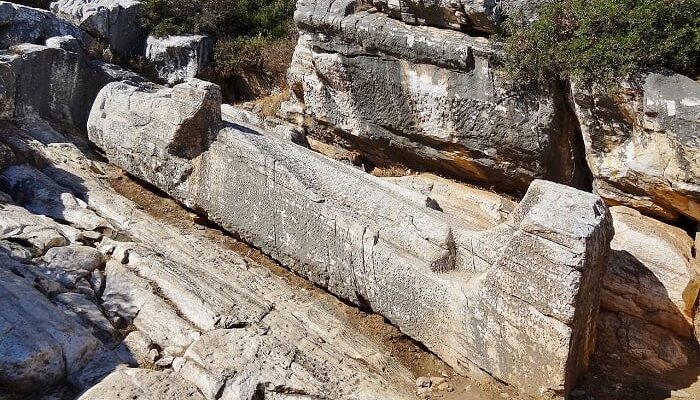
An ancient giant statue has been lying on its back for centuries on a hill on the scenic Greek island of Naxos.
The “Kouros of Apollonas,” also called the “Colossus of Dionysus,” is a 10.7 meter (35 foot) tall unfinished statue of light grey, Naxian marble, weighing approximately eighty tons.
It has never been raised up to its full height; for some unknown reason, the giant was left to languish for eternity on the bare ground.
Having been built between the 5th and 4th centuries B.C. the marble statue is situated on the northern part of Naxos, in the picturesque fishing village of Apollonas.
The giant kouros statue in Naxos
The Kouros has a frontal construction with its arms seemingly coming out of its ribs and the elbows bent. In addition, the statue’s left leg is longer than its right leg.
In most cases, kouros statues depict standing, nude, young men with their arms by their sides. It is clear, however, that the Kouros of Apollonas was meant to be a depiction of an older man with a beard. His right arm would have been stretched out in front of him.
The archaic Greek kouroi have usually been interpreted as depictions of Apollo, but the Kouros of Apollonas is considered to be a depiction of the Greek god Dionysus because of its beard.
Scientists say that the ancient sculptors were halted in their plans to transport this kouros as a route would have to have been carved into the hillside, and this was never done.
Most assume that it was simply too heavy to transport. Other possible reasons for the statue remaining unfinished are mentioned in myriad tourist guidebooks and websites.
There is a claim that the cracks in the statue were not spotted until late in the production process. Alternatively, ancient sculptors may have been concerned that the statue would break if it were to be moved.
The reason could also have been something as prosaic as lack of funding for continued work on the gigantic statue. In any event, the spirit of this colossal statue lives on through the centuries despite its unusual nature.
Naxos: Island overtaken by history
Naxos is the largest island of the Cyclades, and although it is comparatively unknown relative to Greece’s many other island idylls, it is one of the most enchanting places.
Despite flying somewhat under the radar, the island is one of the most interesting places in Greece. It boasts a magnificent history, with influences from the Franks and the Venetians, who are responsible for numerous monuments from the Middle Ages. The island is completely overrun by history.
Apart from boasting a fascinating past, Naxos possesses a lovely natural landscape, since it is the greenest island in the Cyclades archipelago. In addition to having beautiful beaches, its rural villages are set against a backdrop of green valleys and mountains.



